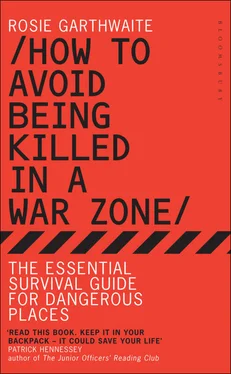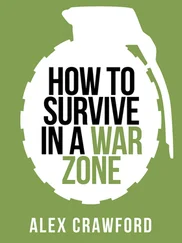Action:Find any way you can to make the person comfortable and give plenty of liquid. Avoid all dairy produce, as that will aggravate the stomach. When they can start eating again, try simple foods – pasta, bread, biscuits and potatoes – before moving onto a normal diet. If the condition is very serious, the loss of fluid could lead to shock (see Shock). Seek medical assistance. A doctor will be able to prescribe drugs to help relieve the pain.
Look out for bloody diarrhoea – the chances are that it’s dysentery, which requires antibiotics. Seek urgent medical assistance. In the meantime, keep well hydrated with whatever liquid you can keep down. Water with a tablespoon of sugar and half a teaspoon (non-heaped) of salt per pint (500 ml) will work.
Monique Nagelkerke advises: ‘Do not take the usual anti-diarrhoea remedies to stop bloody diarrhoea as this could result in bowel damage.’
Dislocated shoulder or finger
First signs:Obvious deformity, with the bone protruding under the skin where it shouldn’t be. The muscles will spasm and hold it there unless it is put back.
Action:Immobilize the shoulder or finger (see Immobilizing fractures) until you can get proper medical help. It is dangerous mending a dislocation as nerves or muscle can get stuck in the joint. It is also incredibly painful.
If you must tackle the dislocation yourself, this is how you do it. Put your foot in the person’s armpit and pull on the arm until the shoulder clicks back into place. For a hand, pull on the finger until it clicks back into place. Once the dislocated part is back in place, immobilize it (see Immobilizing fractures) and let it rest for some time.
Drowning
Action:Carry out ABC (see ABC – the first checks) until the casualty’s vital signs are normal again. Put them in the recovery position (see Recovery position for adults and children) and start to warm them up. Even if they appear to be fine, they will need proper medical treatment because any residual liquid in the lungs will cause irritation and lead to the airways becoming narrowed a few hours later.
Warning:Drowning can also lead to hypothermia (see Hypothermia).
Dysentery (see Diarrhoea)
Electrocution
If someone has been electrocuted, don’t touch them. You need to turn off the power first – at the mains – not the dangerous plug. If that is not possible, you need to move the source of the power away from them, or them away from it, before you can start treatment. Use a non-conducting tool to help you: a rope to pull the patient away, or a piece of wood, a plastic box or even a book to push them. Once they are safely away from the source of their injury, begin ABC and all other necessary treatment.
If someone has been struck by lightning, you can touch them. But if the injuries allow it, you need to move them away from the site of the incident as quickly as possible before you start treatment. Despite the well-known saying, lightning does actually like to strike the same place twice. Continue with treatment from ABC to secondary checks and deal with their symptoms while waiting for help.
Fever
Usually a sign of other illnesses, fever can arise from infection in the ear, throat or teeth, measles, chickenpox, cholera, flu or meningitis (see Meningitis), but the basic symptoms are the same.
First signs:Temperature above 37°C; cold and shivering, but sweating; headache and pains all over the body.
Action:Put the casualty to bed and give lots of cool liquid to replace that lost by sweating. Painkillers may help to bring down the temperature.
Fire
• Switch off all electricity in the room, pulling out the plugs if necessary. Turn off the mains. If you are not sure what the source of the fire is, use a heavy blanket rather than water to put it out. Water on an electrical fire or a flaming pan of fat will make the problem worse.
• If the room is filled with smoke, stay low. Air will be clearest at floor level. Shut the door of the room you are in and put a blanket along the bottom of it. Now open a window.
• If someone’s clothes are on fire, move them to the floor so they aren’t standing up any longer – that way the flames won’t rise up to their face. Wrap them in a heavy blanket and roll them on the ground until the flames are out.
• If someone has suffered burns, see Burns.
Fractures
In the field, particularly if you’re a long way from the nearest hospital, you might need to reset broken bones, so it’s a good idea to learn how to hold them in place until you can get some professional help.
Closed fracture
This type of fracture is described as ‘closed’ because the skin is not broken.
First signs:Pain and tenderness, even to the lightest touch. Swelling will start almost immediately. The limb may look distorted or appear shorter than the other limb. If the patient moves, they might feel the bones grating together. Do not try to do this as a test.
Action:If you are expecting medical help to arrive soon, do not attempt to put the bone back in its correct placement. Simply immobilize it (see Immobilizing fractures) and wait for the expert.
If you are not expecting medical help any time soon, you can try using traction, which involves slowly pulling the limb until the ends of the bone fall into place. If you have a helper, keep the traction up while you apply the splint and immobilize the limb (see Immobilizing fractures).
Open fracture
First signs:The bone pierces the skin. It will be very painful and will need professional attention as soon as possible.
Action:Clean and dress the wound, as there is a risk that both the wound and the bone will get infected.
If the limb is too bent by the fracture to splint, you will need to straighten it. You are not trying to put it back in the correct place – you simply want to move it so that you can immobilize it (see Immobilizing fractures) and thus prevent further damage. It is best to do this as soon as possible, before swelling starts, and preferably when the patient is already unconscious. After that, seek medical attention.
Frostbite (see Frostbite)
Head injury
My most recent experience of a head injury was when a friend slipped after several hours of drinking and dancing and hit his head on a table. The blood rushed out – a metre-wide pool about 5 mm thick. We spent five hours in hospital with him, where he was checked and double-checked, but he was fine. In fact, the cut turned out to be tiny – just enough for a 2-cm disco scar and a dramatic tale to tell.
It was a typical head injury: tons of blood and lots of panic, but ultimately nothing much to worry about. I hope that is the worst you ever see. But the reason the doctors paid so much attention to my friend was the risk of brain damage.
First signs of significant brain injury:A fall in the level of consciousness so that the casualty does not open his eyes, except possibly very briefly; does not reply to you, or makes just an incoherent noise; and makes only a generalized withdrawal of a limb to a painful stimulus rather than a purposeful movement. Very dangerous signs of bleeding in the brain are if one pupil (the black centre of the eye) is bigger than the other, or if blood or clear liquid discharges from the eyes, ears or nose. If these signs are present, the casualty needs urgent medical attention.
Action:When signs of brain injury are present, or the casualty is unconscious, dress the wound (see overleaf) and leave the person in the recovery position (see Recovery position for adults and children) with their airway open. Make regular checks of their breathing, circulation and responses to touch or sound till help arrives.
Читать дальше




![Джонатан Димблби - Barbarossa - How Hitler Lost the War [calibre]](/books/385421/dzhonatan-dimblbi-barbarossa-how-hitler-lost-the-w-thumb.webp)







